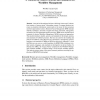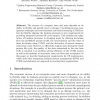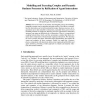CAISE
2008
Springer
14 years 5 months ago
2008
Springer
Effective business processes must be able to accommodate changes in the environment in which they operate, e.g., new laws, changes in business strategy. The ability to encompass su...
BPM
2008
Springer
14 years 5 months ago
2008
Springer
Business processes can be very large and may contain several different concerns, scattered across the process and tangled with other concerns. Crosscutting concerns are difficult t...
ATAL
2008
Springer
14 years 5 months ago
2008
Springer
Business processes are the core assets of enterprises. They turn the business potential into actual competitiveness on the market. To face the challenges posed by today's cha...
WSC
2008
14 years 5 months ago
2008
Typically, system dynamics-based simulations of business processes are constructed in an ad hoc manner, with a modeler creating low-level components and defining interrelationship...
CAISE
2009
Springer
14 years 6 months ago
2009
Springer
Just like web services, business processes can be stored in public repositories to be shared and used by third parties, e.g., as building blocks for constructing new business proce...
AC
2003
Springer
14 years 6 months ago
2003
Springer
Abstract. Over the last decade there has been a shift from "data-aware" information systems to "process-aware" information systems. To support business processe...
EWCBR
2006
Springer
14 years 6 months ago
2006
Springer
The success of a company more and more depends on its ability to flexibly and quickly react to changes. Combining process management techniques and conversational case-based reason...
ESAW
2006
Springer
14 years 6 months ago
2006
Springer
Interaction refers to an abstract and intangible concept. In modelling, intangible concepts can be embodied and made explicit. This allows to manipulate the abstractions and to bui...
ER
2006
Springer
14 years 6 months ago
2006
Springer
The UML 2 Activity Diagram is designed for modelling business processes, but does not yet include any concepts for modelling process goals and their measures. We extend the UML 2 A...
ECTEL
2006
Springer
14 years 6 months ago
2006
Springer
Abstract. The aim of this paper is to provide insight in the important role simulation technologies can play in the context of effective business process-oriented learning. The gap...





